Malware research draft 1
Computer security, cybersecurity, IT security, or information security are defined as protecting a computer system from theft, damaging the hardware, or infecting the operating system's infrastructure with malicious software (Nandal, 2017). Nowadays, with the internet and the digital transaction carried within the network, the malware problem has become a significant issue among computer and network users (Masud et al.,2011). Furthermore, malware has become a threat for individuals and organisations since it exploits the vulnerabilities in a network for malicious actions.
Malware is malicious software developed by hackers and designed to infect the personal computer without the owner's permission. To steal information or harm the system (Masud, Khan, Thuraisingham, and J. Andreasson, 2011). Typically, malware infects a computer through email, website, or external hard devices. (L. Hosch, 2020). Viruses, worms, Trojan horses, spyware are all types of malware, and there are several other types of malware (Masud, et al., 2011). Hence, malware might perform distributed denial-of-service attacks or send spam as a form of a botnet and take over a computer and turn it into a zombie computer (L. Hosch, 2020). Not being aware of having an infected computer is common, as owners of these computers think it just a glitch or find an unidentified file that cannot be removed (L. Hosch, 2020). Therefore, it is necessary to raise the user's awareness and install the essential software to fight such a problem.
Viruses are malicious software that replicates themselves into the host without permission. From displaying messages to wiping the hard drive data, a virus could exhibit those kinds of malicious behaviour. Viruses can infect the host computer when brought in contact with the infected machine via a shared network drive, removable media, or file attachment. "Viruses are not independent programs" and are normally attached to binary files. (Masud et al., 2011). Viruses could target three different sectors. 1- boot sector virus. It is a piece of code that runs every time the computer is booted. 2- File virus. The most common type. Infecting executable programs runs every time the infected program is run. 3-Macro virus. Unlike the file virus, a macro virus infects documents. And it can be executed every time the document is opened (Nandal, 2017). Therefore, installing anti-virus software is required to avoid these kinds of infections and avoid responding to emails with unknown sources and malicious files.
There are other kinds of malware, and each works differently. For example, worms, unlike viruses, worms do not have to attach themselves to a binary file or documents (Masud et al.,.2011). Worms spread and propagate themselves through the computer network (Nandal, 2017). Worms exhibit a number of malicious behaviour such as spamming and phishing, deleting date from hard drive, etc. Worms can be detected by scanning their signature to the one on the database using commercial antivirus software. Another type is rootkits, which is one of the worst (L. Hosch, 2020). It always hides, making it almost impossible to detect and remove it (Nandal, 2017). if it was found, it is almost impossible to remove erasing all data from the hard drive.
Moreover, ransomware. Ransomware works by encrypting the machine's data and freezing it to ask the owners for money in return for the encrypting key(Nandal, 2017). For example, the attack (WannaCry ) on windows in 2017. Wannacry cyberattacks affected more than 200,000 computers in 150 countries (A. Mattei, 2017). The hackers also affected big commercial and governmental institutions. To prevent being threatened of erasing your data by a hacker, it is always good to have a backup copy on an external device. Moreover, regularly updating the system.
References :
- Hosch L., W., 2020. Malware. [online] Britannica Academic. Available at: <https://academic-eb-com.proxy.library.dmu.ac.uk/levels/collegiate/article/malware/474439> [Accessed 18 October 2020].
- Mattei A., T., 2017. Privacy, Confidentiality, And Security Of Health Care Information: Lessons From The Recent Wannacry Cyberattack. [ebook] Elsevier. Available at: <https://www-sciencedirect-com.proxy.library.dmu.ac.uk/science/article/pii/S1878875017309968> [Accessed 18 October 2020].
- Mattei A., T., 2017. Figure 1. Screenshot Of The Ransom Note Left On The Systems Infected By The Wannacry Worm.. [image] Available at: <https://www-sciencedirect-com.proxy.library.dmu.ac.uk/science/article/pii/S1878875017309968> [Accessed 18 October 2020].
- Masud, M., Khan, L., Thuraisingham, B., and J. Andreasson, K., 2011. Data Mining Tools For Malware Detection. 1st ed. [ebook] Auerbach Publishers, Incorporated, p.37. Available at: <https://ebookcentral.proquest.com/lib/dmu/detail.action?docID=826949> [Accessed 18 October 2020].
- Nandal, P., 2017. Malware Detection. 1st ed. [ebook] Diplomica Verlag, p.6. Available at: <https://ebookcentral.proquest.com/lib/dmu/detail.action?docID=5735903> [Accessed 18 October 2020].



Very good essay Reema, you provide an in-depth discussion about the types of malware, their behavior and other characteristics associated with them. I see evidences of referencing too although not all are done in the harvard style. In addition to this, i will like to see additional references.
ReplyDeleteAlthough you mention the dangerous effects of malware, however you fail to mention anything about mitigation strategies that are adopted to prevent against malware in general, this discussion should form the second part of the main body of your essay.
In your conclusion you can analyse both discussions from the main body, and provide your opinion on whether you think malware will evolve to become more advanced or if we are likely to see better security software to protect computers and networks against malware.